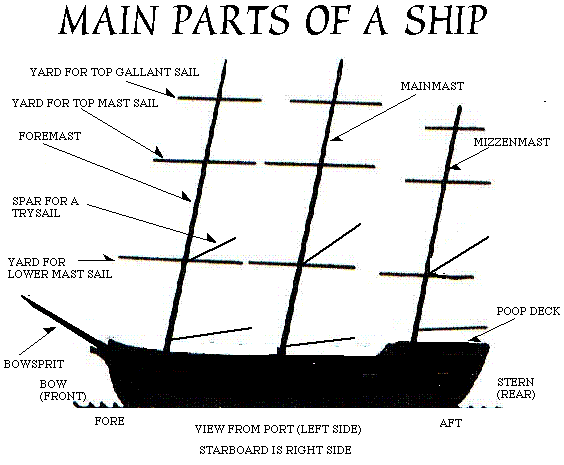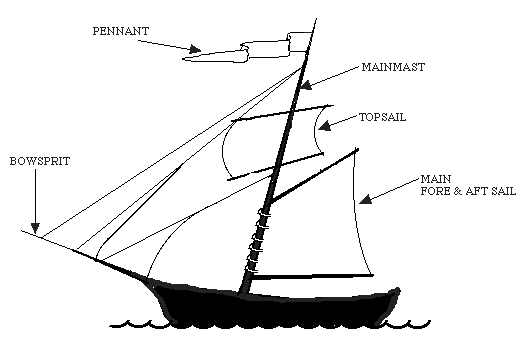By this time, we could observe two tier of guns in the ship which pursued us, and which was now but two short miles astern. This discovery had an evident effect upon the sailors, who did not scruple to say, that we should be torn to pieces, and blown out of the water, and that, if in case any of them should lose their precious limbs, they must go a begging for life, for there was no provision made by the merchants for those poor souls who are maimed in their service.
The captain, understanding this, ordered the crew abaft, and spoke to them thus: "My lads, I am told you hang an a--se. I have gone to sea thirty years, a man and a boy, and never saw English sailors afraid before. Mayhap you may think I want to expose you for the lucre of gain. Whosoever thinks so, thinks a d--ned lie, for my whole cargo is insured; so that, in case I should be taken, my loss would not be great. The enemy is stronger than we, to be sure. What then? have we not a chance for carrying away one of her masts, and so get clear of her? If we find her too hard for us, 'tis but striking at last. If any man is hurt in the engagement, I promise on the word of an honest seaman, to make him a recompense according to his loss. So now, you that are lazy, lubberly, cowardly dogs, get away and skulk in the hold and bread-room; and you, that are jolly boys, stand by me, and let us give one broadside for the honour of Old England."
This eloquent harangue was so well adapted to the disposition of his hearers, that one and all of them, pulling off their hats, waved them over their heads, and saluted him with three cheers; upon which he sent his boy for two large case-bottles of brandy: having treated every man with a dram, they repaired to their quarters, and waited impatiently for the word of command.
From the Adventures of Roderick Random by Tobias Smollett.
Ship Basics
One of the most confusing aspects of ships during the golden age of piracy is all the confusing names tossed around to describe a ship. There is Galleon and Sloop, Brig and Man-O-War, and still Bark and Frigate. Let's not even talk about Hoys, Yachts, and Carracks. Some have three mast and others have four. Still another ship may have only two. And what makes a ship a "ship of the line" versus a "merchantman". In short, it all depends on what the ship is designed to do and when it was doing it.
The Galleon and the Sloop are probably the two most important ships when it comes to the Golden Age of Piracy. The Galleon evolved from the Carrack, a two masted ocean going merchant vessel. If you've heard of the Santa Maria, then you know what a Carrack is.
Overtime the Galleons became larger and more powerfully armed.
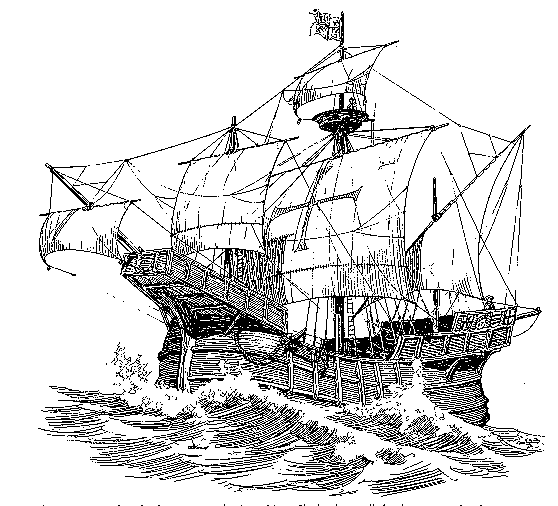
Carrack, 1490s
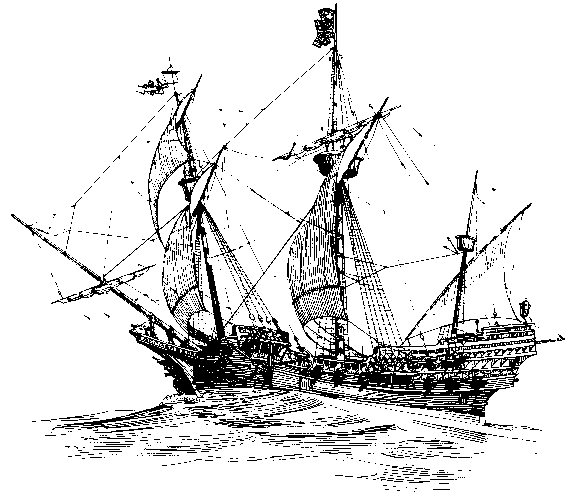
Galleon, around 1600
A Comparison of Sizes
Below is a chart showing the various sizes of different ships.
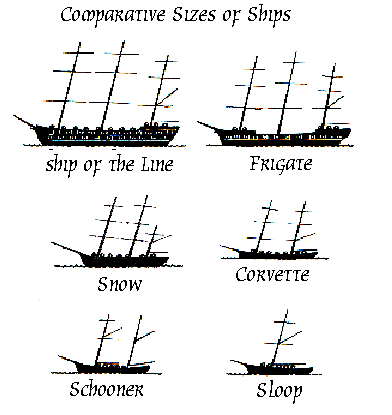
Rigging Basics
If you think you're confused about what type of ship is what, then you're in good company. Ship rigging is very confusing and rarely explained in anything resembling English. This section will try and clarify how the ships are rigged, that is how the sails are arranged.
Three things will determine what kind of ship you're about to board:/p>
- The number of masts
- The way the sails are attached to the mast
- The number of gun decks
A mast is the tall pole sticking up from the deck of a ship. Most sailing ships have between one and three mast but some have four. To simplify matters I'm going to only discuss ships of three masts or less.
Each mast has a particular name:
- Foremast: the front mast on three masted ship
- Mizzenmast: rear mast of ship with more than two masts
- Mainmast: middle mast of three masted ship or the tallest mast of two masted ship or the only mast on a one masted ship.
Sails are usually rigged in one of two fashions. The rigging is often used to determine what kind of ship you're looking at. Sometimes only one style of rigging is used throughout the vessel but in some cases there is a mix of both types of rigging. Rigging is simply defined as the way the sail is attached to the ship.
A sail can be attached to a "yard"or "yardarm" which is a cross beam on the mast which is permanently attached. Or it can be attached to a gaff, which is a spar (beam) that juts out from the mast and usually angled upward. The gaff is moveable and is what is used in "Fore & Aft Rigged" ships.
Other sails
- Jibs are triangular stay-sail stretching from the outer end of the jib-boom to the fore-topmast head in large ships, and from the bowsprit to the mast-head in smaller craft.
- Spankers are the fore-and-aft sail, set with a gaff and boom at the aftermost part of the ship.
- Jibs are in front, spankers — in the rear.
- Stay Sails are a triangular sail hoisted upon a stay.
Which leads us to Stays which are large ropes used to support a mast, and leading from its head down to some other mast or spar, or to some part of the ship. Stays leading forward are fore stays. Stays leading to the back are Aft stays. Finally stays which lead down to the vessel's sides are backstays. Along with this, the stays also are named after the mast they serve such as forestay for the Foremast and mizzenstay for the mizzenmast.
Types of Rigging
As I said, there are two basic ways to rig sails:
- Square Rigged — a rig in which the sails are bent to the yards carried athwart the mast and trimmed with braces. The advantage is the square rigged sails are quite sturdy and can catch a lot of wind.
- Fore & Aft Rigged (Sloop Rigged) — a rig in which the sails are not attached to the yards but are bent to gaffs or set on the mast or on stays in the midship line of the ship. The advantage is increased maneuverability.
To add to the confusion, some ships also possessed lanteen sails which were used heavily in the Mediterranean on merchant ships. The lanteen is a sail shaped like a right triangle. Lanteen sails added to the maneuverability of the ship, allowing ships to sail in directions other than directly with the wind. However they were not as good for speed because they caught less wind than a square sail. Typically the Lanteen had a yard arm which is loosely affixed to a mast and hangs diagonally. This allows for the sail to be shifted about to catch the wind. Lanteens are common among many small sailing vessels in use today.
Gaff sails also helped in maneuvering ships. Gaff sails hung from a gaff or spar extending from a mast on a ship.
Of course, to complicate the matter, you'll run across numerous other terms for the way a ship is rigged. Here are the most common terms:
- Ship
- A veseel square rigged on three masts.
- Brigantine or Barq Rigged
- Msquare rigged Foremast (front) . Fore and aft rigged on the other masts (This can be confusing especially when you compare Barqs an Barquentines).
- Schooner or Sloop Rigged
- Sails rigged fore and aft but sometimes carrying a square rigged top sail on the mainmast (one mast, sloop, more than one mast, Schooner, no matter how many masts).
To further complicate the matter, Square rigged ships also have gaffs on every mast. These gaffs are there to rig fore & aft sails in the event of storms. These special sails are called Trysails. In the event of heavy seas or violent storms the square rigged sails would be put away (shorten sails) and try sails are sometimes used in their place. If the square rigged sails were left in place three possible disasters could occur:
- The strong winds could rip the square rigged sails from the yards.
- If the sails aren't torn from the Yards then the masts stand a good chance of breaking due to the added weight of the wet sails or simply from the wind.
- If the masts doesn't break, the sails could force the ship to capsize, that is roll over in the water.
The trysails are smaller and attached only to the bottom portion of the mast. This reduces the possibility of the ship capsizing and also reduces the strain on the very tall masts. Because the try sails are rigged fore and aft they assist in the maneuverability of the ship during the storm.
Try sails are also used in order to increase speed, improve maneuverability and improve a ship ability to sail when sailing against or in a direction other than the wind.
Decks
As each mast had a name so do the decks.
- Poop
- The aftermost part of a ship; the stern; also, the aftermost and highest deck, often forming the roof of the cabin built in the stern.
- Forecastle (fo'c'sle)
- (never called the forecastle deck) A short raised deck at the fore end of a vessel. In early use raised like a castle to command the enemy's decks. the forecastle also refers to the forward part of the merchant vessel, under the deck, where the sailors live.
- Spar
- The spar deck extended from stem to to stern and rest above the main deck. It is usually devoid of guns but not always. Frigates typically would fill about half the spar with guns. This deck is not found on a merchant ship.
- Main
- This is the deck just below the spar deck on a man of war or the deck that rest between the poop and fore-castle on a merchant ship. The main deck will be the upper most deck on a man-o-war being with a full compliment of guns The guns on this deck are sometimes referred to as main-deckers. This means the guns rest on the main deck (if there is just one deck of guns, it is called the gun deck) and the spar deck acts as the ceiling.
- Lower Deck
- The second deck containing guns, if the ship had only two decks containing a full complement of guns.
- Middle Deck
- The middle deck of guns when the ship of the line carried three decks of guns. If a middle deck existed the lower deck. obviously becomes the third deck of guns.
- Berth
- The deck below the gun decks where the mess, sick bay, living/sleeping quarters were found. The berth was often at or just above the water line and was devoid of proper lighting and poorly ventilated
- Orlop
- The orlop (normally not called the orlop deck, just orlop) is the lowest deck on a ship usually covering the hold. Quite often the magazines (ammunition rooms) would be found under the orlop, typically aft on war ships. Remember to get to the hold, you have to pass under the orlop. The hold resides between the orlop and the bilge.
- Bilge
- The bottom of a ship's hull, or that part on either side of the keel which has more a horizontal than a perpendicular direction, and upon which the ship would rest if aground; also the lowest internal part of the hull.
As you can guess, not all ships or boats have every deck. for instance a sloop may only have one deck which then becomes the "deck" and everything else is below deck. Or you may have a spar deck, gun deck and then a hold.
Gun Decks
The number of decks containing guns is a determining factor when discussing Man-O-Wars or fighting ships. Fighting ships fall into four basic classes:
- Those with one gun deck and less than three ship rigged masts (corvettes, snows)
- Those with one gun deck and three ship rigged masts (ship)
- Those with one and half gun decks and three ship rigged masts (frigates)
- Those Ships with two or more full gun decks (Ship of the Line)
As you can assume, there were hybrids and exceptions to these descriptions. Typically, the number of masts on on a Man of War would give some clue as to how many gun decks she would have.
Merchant ships would also be armed but most likely not as well armed as a man-o-war. More likely the merchant ship would only have one gun deck and or a few guns strapped to the spar.
Hopefully this information will assist you when reading the descriptions of specific sailing vessels.
Main Parts of a Ship
See next figures for diagrams labeling the vital parts of a standard pirate ship and a sloop.

The only author and editor of all pages on the site. Most of what I write about is based on years of book reading on the topic. My first web page was published back in 1994.
